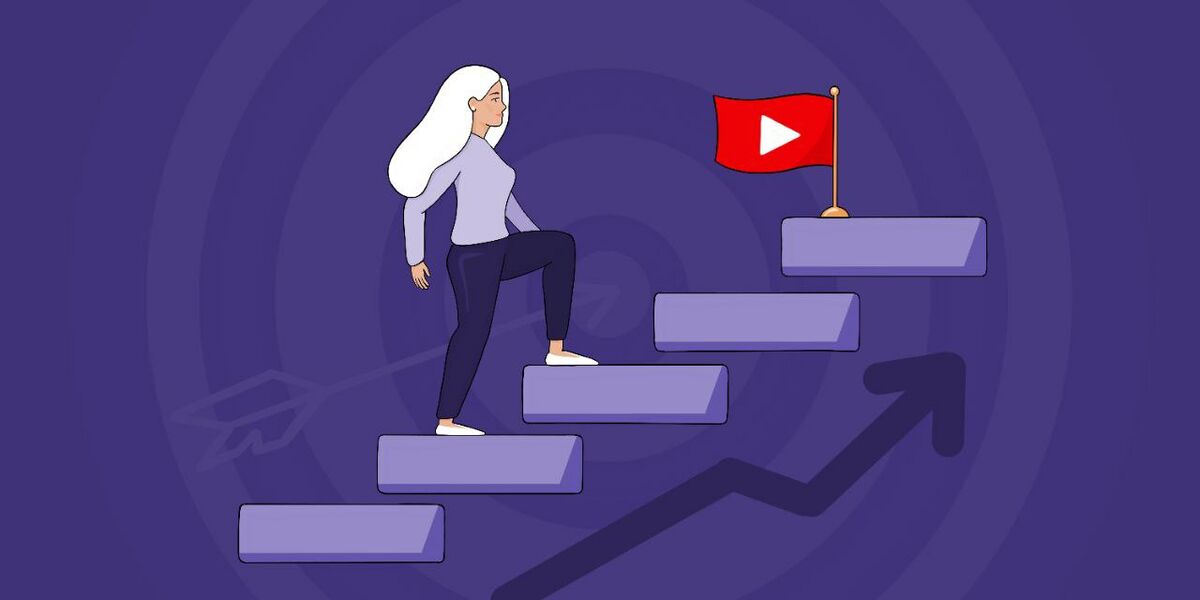5 Steps To Take Before Starting a YouTube Channel
You've probably wondered, ‘Where should I begin if I want to start a successful YouTube channel?’ What should you do in advance and be prepared for?
We all want to hurry up and press upload so that views will begin streaming into the channel, so we forget to perform the most banal, basic steps, which exist to help our channel grow.
So, what do creators overlook when creating a channel?
First step: formulating the idea
The idea is at the forefront of everything - be it a video or a channel, a painting or a business, a book or a whole movie. No one starts a company with the words, "We'll figure out what to do as we go." This lack of a strategy seems inherently doomed.
The idea is born the moment the thought arises: "Why don't I create a YouTube channel?" And if you just want to start a channel but don't know what to do on it, you have the desire to create a channel but have no idea. And without it, nothing substantial will be created.
Let's think about where the idea for a channel can come from in the first place:
- From your hobbies - if you're good at knitting, drawing, rocket building, or reading a lot. Why not share your hobby with others? Demonstrate your knowledge and skills, find like-minded people.
Examples here are probably endless: from car channels to handicrafts, from expert channels with tutorials to entertaining compilations with current memes.
- From your work - you are a specialist, you have knowledge and experience in your profession, so you can help others by sharing knowledge.
In this format, the idea can be motivated by two reasons: you altruistically want to share your knowledge to make the world better, or you want to expand your customer base, so you plan to demonstrate expertise in the subject.
It's not excluded that both motives drive you simultaneously, and this is even better. Because the desire to help will protect you from useless clickbait and deceit for profit, and the desire to earn can finance your content with excellent video and audio quality.
- From your lifestyle - you have rich experience in relationships, in raising children, you are a vegetarian, lead a nomadic lifestyle, or follow a "slow living" lifestyle. Any lifestyle, depending on how you present it, can become the fundamental idea for your channel.
You've probably encountered individuals on YouTube or other social media who emit a distinct mood and atmosphere that is unmistakable. If you enjoy something like that, you will be drawn to that particular vlogger and their style.
For example, if you're into a healthy lifestyle, you'll look for someone who shares your views. If, at the same time, you prefer a calm and measured life, you're unlikely to want to watch a crazy daredevil, even if they lead a healthy lifestyle overall.
- An original idea falls into the category of thinking outside the box. For example, you've come up with a unique video format that hasn't been seen anywhere else, or perhaps you've thought of a character on YouTube that would be in demand with viewers.
So, you could be inspired by your own cat, snail, or pet snake if you realize that your pets create lots of fun content that you can shape into a coherent form.
Or perhaps you've recognized that YouTube lacks a superhero, which you happen to be. You develop your character, craft an entire story, and share it with people.
Of course, these are not the only ways to draw inspiration when developing an idea, but try them if you don't have any ideas.
Your idea should resonate primarily with you and align with your values and interests. If you choose something purely based on trends or what's interesting to viewers, you might burn out quickly.
Your goal is to create content for the long term, so the channel's idea should go hand in hand with you for many years.
Second step: exploring your niche
It would be strange if formulating the idea was the end of it all. A vast number of talented creators come up with ideas by the dozens, but implementing them successfully is a completely different matter.
YouTube's uniqueness lies in the fact that it's an open platform, and practically anyone can join. Hence, there's enormous competition among creators.
Viewer attention is precious, so if you want to get it, you'll need to consider everything that other creators have already offered.
It's important to objectively assess yourself based on the following criteria:
- Your skills: what can you give to viewers, how can you supplement the information that is already on the platform, or how to present it in a new way.
- Your capabilities: if all the creators in the niche shoot on professional cameras with a whole team, then you will have to meet this high bar. If there are only a couple of creators in your niche, then the “starter pack” of any vlogger in the form of a phone and microphone will be enough at first.
For example, Prodvigate's niche is marketing and promotion. The specific theme is YouTube promotion. Therefore, the team's tasks include daily monitoring of YouTube for novelties and changes in both the narrow YouTube theme and the niche as a whole, to keep up and even provide information beyond what's readily available.
It's important to understand that the peculiarities of the niche are shaped by what already exists within it and what creators offer their viewers. Thus, the minimum entry threshold for your channel in the niche will be determined by viewer expectations. This includes the quality of content they are currently being offered, which topics are trending, and whether your knowledge and presentation format are up to date. Only through an analysis of the niche and its competitors can you move on to more specific steps.
- Advice: when you study a niche and think about topics for videos, do not just look for relevant or hype ones, for which thousands of videos have already been shot, but look for what people are looking for that they don’t have.
The secret of successful videos or even entire channels that skyrocket overnight is that the creators have identified the supply and demand within their niche. They didn't just stumble upon some obscure topic that no one had covered before; they found what is in demand by viewers, yet underrepresented or poorly covered on YouTube.
It's during the process of niche research that you can pinpoint these so-called gaps in your niche.
Third step: think over the visual
The visual component of a channel is not only about adding a header to the channel and thumbnails to the video. It's more about how you want to be perceived and remembered by the audience.
Let's look at two channels:: «Little King Goods» and «Helena's Craft».
You'd be surprised, but all of them come from the same niche - handmade and hobbies. On these channels, people create things with their own hands, but each of them evokes different feelings in you, and you remember them for different reasons.
Each of these creators has established a specific color palette that triggers associations and moods in our brains. Before you even click play the channel owners have created a sense of the atmosphere on their channel among viewers.
So when we talk about visuals, we're not just referring to the design of the banner and thumbnails.
Which colors reflect your personality? How well do these colors harmonize with the theme of your channel? After all, if you narrate goth subculture in a rainbow and glittery style, it might seem a little strange. Creativity is essential, but the key is not to overdo it and turn everything into a tasteless mess.
You need to think through every detail, from your avatar to animations and the style of your video titles. How do you envision your videos? What kind of titles represent your mood, or even your signature style? What editing or shooting techniques do you want to use on your channel?
Every detail of your channel and videos contributes to the overall atmosphere and emotions you evoke in viewers. Just think about events or objects that didn't trigger any emotions for you; they probably didn't stick in your memory. The same goes for YouTube.
If external parameters are somewhat understandable, creating the most crucial visual identity is much more complex. Here, we're talking about you, your character on the screen.
The character, whether or not you appear on the screen, is the composite image derived from what your video represents. Is your character serious or playful? With a mustache or wearing a hat? What's in the background? What Easter eggs do you want to leave for future viewers in your frame? Will you play a role, or will you be yourself? All these aspects need careful consideration in advance because they are what define your channel.
Fourth step: set the channel’s goals and objectives
The goal of your channel is like a coveted trophy that you'll grab when you reach the podium. But don't rush to set the goal of "becoming the best YouTuber."
First of all, this is terribly abstract. It's like setting a goal to "become a good person." Good according to whose standards? Who will be the judge? How can you know what qualities are good and which are bad when everyone has their own perspective? Therefore, you need a clear and measurable goal.
Secondly, it should align with your personal life goal. For example, you want to earn a specific amount of money, and YouTube can be your gateway to that. In this case, the first goal you'll aim for is to start earning from YouTube.
Is it going to be through monetization or collaborations? That falls under the category of tasks.
Tasks are small steps that get you closer to your bigger goal.
So, continuing with the money-making example, you'd need to take steps like creating quality and useful content, continually analyzing your videos and competitors to grow your audience. After all, your audience is your resource to achieving your goal. Here, you should have specific numbers: gain 100 subscribers, then 200, and eventually 1,000. Once you've built up the required loyal audience, you can move on to the next step, perhaps proposing collaborations to a brand, another influencer, or a company.
Yes, my friends, all of this needs to be thought out in advance, even before creating your channel. But the steps and goals can and should be adjusted as you go along, because we can't prepare for every scenario from the start. However, having a plan and a reference point is crucial.
Step Five: Develop a Content Plan and Strategy
Look at us! We've got a clear, measurable goal, a well-thought-out character, a deep understanding of how the niche and theme work, knowledge of our competitors—both their strengths and weaknesses. Before starting, there may seem to be nothing else left to worry about. But there is one more very important step.
The most critical question that you, as a content creator, should ask yourself when developing your strategy is, "Why would someone watch my videos instead of the competition's?"
That's the unique selling point, the crucial difference. Objectively, every niche and topic has been explored by someone. There's almost no unique information left for viewers, except for rare exceptions. But your job is to stand out from all the other creators.
So when you're developing your channel's promotion strategy, it's essential to highlight your unique advantages that will genuinely help viewers, and maybe even future customers.
What else should we think about when working with YouTube?
- Today on YouTube, the subscriber and view counts don't matter. Channels go viral even without them because being unique is more critical than being popular.
- The value you offer doesn't always have to revolve around practical matters like education, knowledge, and earnings. Value can also be found in entertainment, fun, inspiration, and motivation.
- Ideally, every content creator should have a content plan for their channel for at least a month ahead. This is especially true if you have a good understanding of what topics your audience prefers, what might be trending in a particular season, and so on.
When you're just starting, when there's no talk of a channel yet, you need to plan your content for at least two months. Why such an extensive timeframe? In the first three months on YouTube, your main activity will be testing ideas. This is because no one can predict what will take off on your channel, in your niche, with your presentation style, or video format.
The videos and topics that become popular with other creators won't necessarily work for you. There are so many nuances involved - presentation, source material, timing of publication, and many more. Therefore, you'll be experimenting until you grasp the essence of your work, feel the initial results, and can analyze them.
Another reason you need to plan your content thoroughly is that videos should be filmed in advance.
When you're new to YouTube, you might not know how many videos you can handle, how viewers will react to your content, what will or won't appeal to them. So, it's important to plan content that can be analyzed.
Certainly, there are many more steps to consider before launching a channel, and each of these points can be further elaborated in separate articles.
These rules and steps might sound challenging, but let's be honest: the era of easy starts on YouTube is over. The number of creators on the platform has significantly increased, and the quality of content is no longer what it was a couple of years ago. Audiences are looking for new creators, fresh perspectives, and exciting content, so it's in your hands to understand what you can uniquely offer them.





